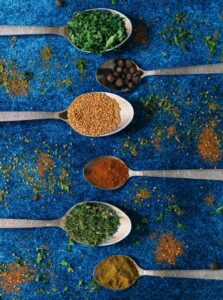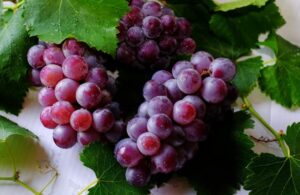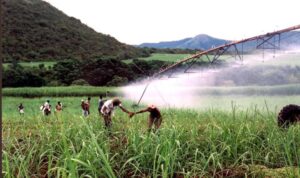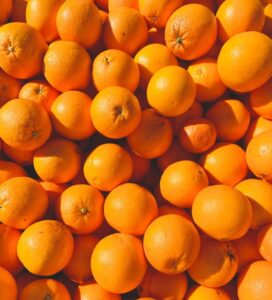Photos above used courtesy of Helen Gordon, WWF SA
Introduction
Our continent is bleeding to death: megatons of topsoil wash out to sea every year due to soil structure degraded by ploughing.
Conservation Agriculture (CA) – or “Conservation Tillage” as it was often called – is a cost-effective, environmentally friendly method of farming which does not use regular ploughing and tillage, but promotes permanent soil cover and diversified crop rotation to ensure better soil health and productivity. Society also benefits from reduced atmospheric carbon dioxide emissions.
CA (as defined by the Food and Agriculture Organisation of the United Nations, FAO) has come to be accepted as the umbrella term for describing agricultural farming practices that conserve ecological systems. The most common forms of CA are no-tillage, conservation farming, direct seeding, ridge till, chisel & disc, rip-on-row and stubble mulching.
All of these methods leave plant residues on the soil surface between growing seasons. The plant residues provide a protective cover that diminishes wind and water erosion, reduces evaporation losses, minimises water runoff and can thereby dramatically increase soil water (from irrigation or rain) availability. Organic matter, the key ingredient in soil productivity, increases, as do earthworms, conservation tillage’s ‘biological plough’, reducing diesel requirements by up to 50% or more.
Conservation and efficient utilisation of natural resources at national, regional and farm level is no longer a luxury but an imperative, and the adoption of conservation farming practices an essential component of good farming practice.
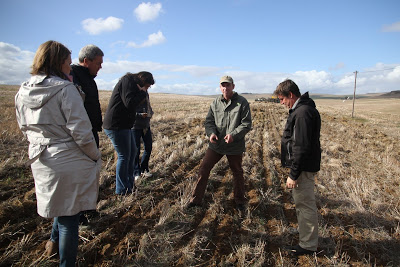
A closer look at Conservation Agriculture. Photo used courtesy of Helen Gordon, WWF SA.
Some forms of Conservation Agriculture
Conservation Agriculture, as defined by the Food and Agriculture Organisation of the United Nations (FAO), is receiving growing acceptance internationally as the optimal crop production system, and includes all farming systems which involve simultaneous adherence to the principles of:
- Continued minimal soil disturbance (including NO soil inversion) – to retain root channels and encourage the build-up of soil biota populations and hence soil structure;
- Permanent organic soil cover (either by living crops or by crop or other plant residues) – to diminish the impact of raindrops and reduce water runoff (and consequently soil loss); and
- Diversification of crop species growing in sequence and/or associations (especially crop rotation) – to increase the diversity of food sources and hence soil biota, especially predators, and break pest and disease cycles.
Note that, although some organic farmers practice Conservation Agriculture, where production systems require the inversion or cultivation of the soil more than is necessary to insert the seed or seedling (for example, in the incorporation of manures), such systems can not be described as Conservation Agriculture systems.
No Till (also called Zero Till or Direct Seeding)
This is a crop production system that involves no seed bed preparation other than the opening (via a slit or punched hole) of the soil for the purpose of placing seed or seedling. No cultivation is performed during the growing season. As with Conservation Agriculture, weed control is accomplished using mulches, allelopathy (the antagonism of some plants or plant residues to other plants), crop rotation or appropriate (preferably narrow spectrum bio-friendly) herbicides.
Minimum Tillage
These are systems that involve minimal soil manipulation for crop production. Also referred to as reduced tillage, Minimum Tillage’s major objectives include:
- to perform the minimum number and severity of operations thought necessary to optimise soil conditions, frequently differentiating between the in- and inter-row areas;
- to minimise the number of trips over the field to avoid soil compaction and structural degradation;
- to conserve moisture;
- to reduce soil erosion; and
- to reduce mechanical energy and labour requirements
Some common Minimum Tillage systems include:
Till and Plant: Tractor-driven equipment prepares narrow strips utilising shallow secondary tillage after the primary tillage and just ahead of the planter.
Strip Tillage: Combination units perform strip or zone tillage just ahead of the planter in untilled soil (usually utilising a chisel plough, with the sole aim of improving porosity and rooting depth in root zone). Specific practices include
- Rip-on-row: A heavy tine at a depth of 300-450mm is drawn in the line of the planned (often also the previous) row ahead of the planter.
- Chisel: Lighter chisel tines are drawn at a depth of 200-300mm as the sole cultivation prior to planting.
- Chisel & disc: Primary tillage is conduced using chisel tines only, followed by a light disc immediately prior to planting.
- Disc-plant: One discing operation before planting is done to loosen the compacted soil surface, to control weeds, and to leave most of the residue on the surface.
- Bed-plant: This method is commonly used for soil moisture management especially in surface irrigated crops where furrows are made at appropriate intervals raising the bed between.
Ridge Till
This is a planting method where crops are planted on the ridge top, in the furrow or along both sides of a ridge. The ridges may be on the contours with graded furrows draining into a grassed water way, or use short cross-ties to create a series of basins to store water in ‘tied-ridges’.
Mulch Till
This is a system that involves cutting the roots of weeds and other plants, leaving the crop residue on the surface or mixed into the top few centimetres of the soil.
To plough or not to plough – old and new paradigms in crop production
| Old paradigms | New paradigms |
Soil tillage is necessary to produce a crop
| Tillage is not necessary for crop production
|
Consequences of soil cultivation & bare soil
| Consequences of No-till & permanent soil cover
|
Off farm effects of soil erosion
| Off farm effects of new production system
|
Result:
| Result:
|
Source for above table: After Derpsch 2004.
International business environment
Conservation Agriculture has been tested, proven and is being practised under a wide range of agro-ecological conditions throughout the world, and is a major factor in the growing dominance of South American grain producers on world markets. By emitting less carbon dioxide and capturing more carbon in the soil, CA helps counter the effects of global warming.
- There is an annual World Congress on Conservation Agriculture. Find information on the UN’s Food and Agriculture Organisation (FAO) website, www.fao.org/conservation-agriculture/en/. A number of international links and publications (for download) can be found on this website.
- WOCAT (World Overview of Conservation Approaches and Technologies) is an established global network of Soil and Water Conservation (SWC) specialists, dedicated to sustainable land management (SLM). Visit www.wocat.net.
- The African Conservation Tillage Network (ACT), www.act-africa.org.
- See the Project Drawdown notes on CA at https://drawdown.org/solutions/conservation-agriculture.
- www.rolf-derpsch.com – Rolf Derpsch is a well-known advocate of CA overseas. Dr Ademir Calegari of Brazil’s Institute of Agriculture is another. See www.idrparana.pr.gov.br
- No-till on the Plains, a non-profit educational organisation in the USA – www.notill.org
- NO-TILL FARMER, www.no-tillfarmer.com
- La Asociacion Argentina de Productores en Siembra Directa (Aapresid), www.aapresid.org.ar, the Argentina Association of Direct Seeding Producers
- Conservation agriculture is championed by the International Maize and Wheat Improvement Centre. See www.cimmyt.org.
- The Centre for Learning on Sustainable Agriculture (ILEIA) coined the acronym LEISA (Low External Input Sustainable Agriculture), www.ileia.org
- Find out about the European Conservation Agriculture Federation at https://ecaf.org.Numerous organisations and contact details are listed.
- There are notes on conservation tillage (and much else) on the Conservation Technology Information Centre (CTIC) website, www.ctic.org.
Local business environment
The Western Cape has the highest adoption of conservation agriculture in the country, with around 70% of grain farmers practicing reduced tillage (Elsenburg, 2019). There’s a strong group of no-till farmers around Bergville and Winterton in KZN. These areas lead the way with CA in the country.
As producers realise the benefits of the system, especially in drier years, this will change. South Africa is a water-scarce country and there’s limited soil for agricultural production. The use of no-till helps with carbon sequestration and lowers the loss of carbon and moisture from the soil. It prevents large-scale erosion through wind and water. CA helps improve soil health, leading to improved yield and sustainable production over time.
The practice of no-till has grown immensely in SA and involves emerging farmers as well. Smaller planters and sprayers have been developed for them.
Source: Dr Johann Strauss and Richard Findlay
National strategy and provincial contact
The Agricultural Policy Action Plan (APAP), based on the Department of Trade, Industry and Competition’s Industrial Policy Action Plans (IPAPs), featured CA under the Promoting Climate-Smart Section.
Find information on, and contact details for, the different directorates of the Department of Agriculture, Land Reform and Rural Development (DALRRD) at www.dalrrd.gov.za.
Provincial Departments of Agriculture that are involved with CA initiatives include the Eastern Cape Department of Agriculture, KwaZulu-Natal Department of Agriculture and Rural Development and the Western Cape Department of Agriculture. Find their details on the “Agriculture in the Provinces” page.
Role players
Further reference:
Training and research
- Institutions offering agricultural degrees/diplomas include CA in the syllabus.
Animal-drawn No Till Planters
- Refer to the Afritrac listing above. Eden Equip and Inttrac Trading also supply these in addition to tractor-drawn implements.
Manual
- Refer to the Backsaver listing above. Eden Equip also supplies these.
Consultants
- Role players listed earlier under earlier headings (e.g. Grain SA and the ARC) are available to offer advice.
Websites and publications
Visit the websites listed earlier on this page.
- 9th World Congress on Conservation Agriculture – WCCA9 https://wcca9.org
- The excellent, annual Maize Information Guide (MIG) from the ARC includes notes on CA. Download the publication at www.arc.agric.za.
- Call 012 842 4017 or email iaeinfo [at] arc.agric.za for the following publications, available from the ARC in Silverton: (i) Jukke vir dieretrekkrag (ii)Yokes for animal traction (iii) Animal traction implements (iv) Comparative review of technical specifications for no-till jab-planters
- ASSET Research has several booklets and papers on CA. Visit www.assetresearch.org.za.
- No-Till Advantages and Benefits in Crop Production and The Beginner’s Guide to No-Till by Aubrey Venter, and A Guide to No-Till Crop Production in KZN, 2nd Edition (1999). Available from the KZN No-till Club. A booklet on no-till is alsoavailable in isiZulu.
- Find No-Till for KwaZulu-Natal’s small scale farming systems by Charmaine Mchunu and Alan Mason, and other documents on the KwaZulu-Natal Department of Agriculture website, www.kzndard.gov.za.
- Find the “Introduction to Conservation Agriculture” manual and other resources on the Mahlathini Development Foundation (MDF) website, www.mahlathini.org.
- Conservation Agriculture in Africa. Ademir Calegari, John Ashburner & Richard Fowler. FAO, Accra 2005. ISBN: 9988-627-04-01.
- Find videos on YouTube like “Weed Response to No-Till and Cover Crops, Randy Anderson” and “Seedling Emergence in Conventional and No-Till Fields“.
- No-Till Farming Systems. 2008. Special Publication No.3, World Association of Soil and Water Conservation, Bangkok. ISBN: 978-974-8391-60-1, 544 pp. A global collection of information presented by farmers, extension specialists, discipline professionals and research scientists.
- Conservation Agriculture: A manual for farmers and extension workers in Africa. 2005. IIRR, Nairobi and African Conservation Tillage Network (ACT), Harare. Obtainable from admin [at] iirr-africa.org.
Some articles
- Read our blog “Building the Business Case for Conservation Agriculture and Redefining Our Approach to Feeding the World“
- Read the BLWK Nuusbrief/CAWC Newsletter at https://blwk.co.za.
- Conservation Agriculture is frequently covered in both agricultural weeklies Landbouweekblad and Farmer’s Weekly. An example follows: (i) Marais S. 2022, July 13. “The benefits of conservation agriculture”. Farmer’s Weekly. Available at www.farmersweekly.co.za/farming-basics/how-to-crop/the-benefits-of-conservation-agriculture/
- Rakau P. 2025, January 25. “No-till success: How conservation agriculture restored a failing farm”. Food for Mzansi. Available at www.foodformzansi.co.za/no-till-success-how-conservation-agriculture-restored-a-failing-farm/
- Manoko T. 2024, July 25. “Farmers urged to embrace conservation agriculture”. Food for Mzansi. Available at SA News. Available at www.foodformzansi.co.za/farmers-urged-to-embrace-conservation-agriculture
- Burleson J. 2020, May 2. “Four decades of no-till study proves nature knows best”. Lincoln Journal Star. Available at https://journalstar.com/business/agriculture/four-decades-of-no-till-study-proves-nature-knows-best/article_6aea2d25-e0c2-5eec-9094-f216060d5735.html
Our gratitude to the late Richard Fowler and Dirk Lange (University of Fort Hare) for notes used on this page.

